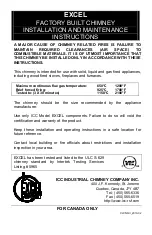
5
The relevant parts of the current editions of the following British Standards:-
BS 715
BS 6461 Part 1 & 2
BS 1251
BS 6891
BS 4543 Part 2
BS 7556
BS 5440 Part 1 & 2
BS 8303
BS 5871 Part 2 & 3
In other countries the installation must also conform with the national and local regulations in force.
Installation Requirements
As supplied the appliance can be installed in the following situations:-
To a non-combustible fireplace complete with surround and hearth with dimensions as shown in Fig.
1 fireback. The chairbrick, if fitted should be removed to obtain the Minimum dimensions as shown
in Fig. 1. The required fireplace, hearth, debris catchment area and clearance dimensions are
shown in Fig. 1.
For a 16” fire, a fireplace incorporating a metal flue box complying with the constructional
requirements of the current edition of BS 715. The internal dimensions of the flue box must conform
to the opening shown in Fig. 2.
Note BS 5871 requires a minimum debris collection space of 2—12 litres depending upon the type
of flue.
Suitable Flues and Minimum Flue Sizes are as follows:-
a) 225mm x 225mm conventional brick flue.
b) 175mm diameter lined brick or stone flue.
c) 200mm diameter factory made insulated flue manufactured to BS 4543.
d) 175mm diameter flue pipe. See BS 6461 Part 1 for suitable materials.
e) For 16” model only. Single wall, twin wall or flexible flue liner of minimum diameter 125mm. The
materials to be used are stainless steel or aluminium as specified in BS 715.
It should be noted that, as with many appliances, sharp bends or horizontal runs in metal flues at the
top of the system can be a cause of problems in these types of installation.
The minimum effective height of the flue must be 3m.
The flue must have a positive updraught.
The flue must not be used for any other appliance or application.
Any chimney damper or restrictor should be removed. If removal is not possible, they must be
secured in the fully open position.
If the appliance is intended to be installed to a chimney which was previously used for solid fuel, the
flue must be swept clean prior to installation. All flues should be inspected for soundness and
freedom from blockages. Where the fire is to be installed beneath a particularly deep lintel
supporting the chimney breast and the flue outlets might be partially obscured, steps must be taken
to chamfer the underside of the lintel to provide a smooth unrestricted path for the gases.
Any underfloor vents or openings within the builders opening should be sealed off.
The appliance must be mounted on a non-combustible hearth (N.B. con-glomerate marble hearths
are considered as non-combustible). The appliance can be fitted to a purpose made proprietary
class “O”-150°C surround. The hearth material must be at least 12mm thick.
The periphery of the hearth (or fender) should be at least 50mm above floor level and extend
300mm in front of the fire and 150mm either side.
Summary of Contents for MK6
Page 6: ...7 Fig 1 Fig 2 ...





































